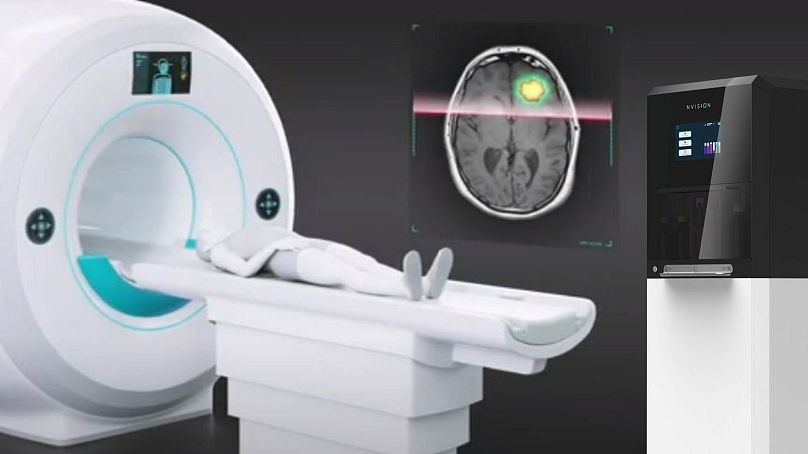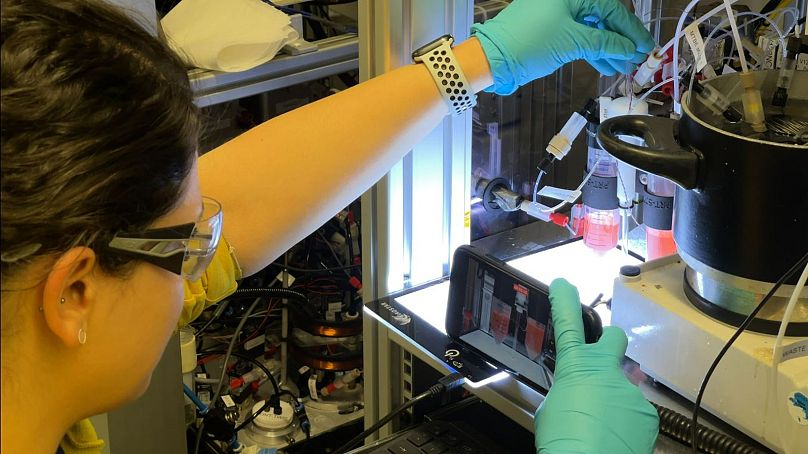NVision leverages quantum technology to make MRI imaging 100,000 times more precise, using existing machines.
A German start-up supercharging MRI imaging could save lives by allowing doctors to see much more quickly and precisely whether a cancer treatment is working or not.
NVision’s “hyperpolarisation” technology uses quantum physics to enhance the magnetic signal of molecules in the human body by up to 100,000 times using standard MRIs.
The technique allows MRI imaging to show changes in cells at a metabolic level, providing much more information than at the tissue level and revealing, within days rather than months, whether a cancer therapy is effective or a tumour is spreading.
“Some patients just don’t have time. One failed treatment is almost a death sentence because you really don’t have enough time to change course,” CEO Sella Brosh told Euronews Next.
NVision’s tech aims to turn MRI imaging into a “completely different ball game,” he said.
How do MRIs work, and what does this tech do differently?
MRIs use the magnetic signature of water to spot where it is located in the body and how it’s affected by the surrounding tissues. Water in the blood will look different from water in the muscle or in the skin, resulting in different magnetic signatures that create an anatomical image of the body.
We have so much water in our bodies that this signal is very strong. But where MRIs are lacking, Brosh explained, is in detecting the other small molecules in our body, also known as metabolites.
“Metabolism is life, it’s how we survive, and it’s how tumours and cancers survive and grow, using energy,” Brosh explained. “What we do is allow MRIs to become metabolic imagers at scale”.
Instead of making MRI machines more powerful or sensitive, NVision’s tech focuses on making the signal from these metabolites stronger and therefore easier to read by existing machines.
The start-up selected a metabolite, pyruvate, which is essentially a sugar that cancers happen to love. What NVision does is take this sugar, and manipulate the nuclear spins on its carbon atoms, to enhance the molecule’s magnetic signal by 100,000 times on a standard MRI.
“What the MRI picks up is really these spins on top of atoms,” said NVision’s CTO Ilai Schwartz. “The problem with an MRI is that most spins are not oriented in one direction, and then you spin them all and they nicely process together. You have some which are up, some which are down, and they cancel each other out”.
“What we do for our specific sugar is we orient all of them - or almost all of them - in one direction,” he explained.
Sound complicated? Imagine you’re trying to count small toy soldiers scattered all over the floor. If they’re all standing in a neat, straight line, it’s much easier to count them.
Like Google Street View for cells
It’s not just easier for the MRI to pick up these signals, but it can also interpret much more information from them.
One analogy for that extra layer of information is the difference between using Google Maps and Google Street View. On the map, a street is just a line. But if you zoom in and explore it like on Google Street View, you can see what it actually looks like, what seems orderly and what doesn’t.
Making metabolites appear on MRI imaging is of vital importance; it allows health professionals to track how the body processes them and where things aren’t working the way they should.
When pyruvate enters normal cells, some of it turns into lactate, but only a small amount. Cancer cells, however, create much more lactate than normal. Spotting this overproduction of lactate could therefore allow doctors to confidently pinpoint a tumour and see where it’s growing.
“In real-time you’re tracking the sugar as it goes into the cell and transforms into other metabolites,” Brosh explained. “It’s a completely new dimension that MRI can provide you with”.
Think of MRI as a snapshot that shows cars in a car park. They’re still, so we see what they look like, but we don’t know anything about how they function. But give them fuel and watch them drive around, and you’ll see things that go wrong, which ones aren’t sticking to their lane or which ones are speeding up and posing risks.
“That’s exactly what we’re doing here. We’re giving the cells fuel, and looking at how they’re using it,” Brosh said.
Is this safe?
In its labs in Ulm, Germany, NVision prepares this “quantum sugar” and purifies it so it’s safe for injection.
“These are all naturally occurring substances in the body, and they're injected at normal physiological conditions, so it's completely harmless,” said Anna Parker, NVision’s senior director of NMR (nuclear magnetic resonance) hyperpolarisation.
She added that the great advantage of MRI is that it's harmless, and you could do one as many times as needed without incurring damage over time, unlike PET-CT scans or X-rays that expose you to radiation.
But the polarising effect of NVision’s technology only lasts a few minutes, so it needs to be done right before an MRI scan.
All a health worker needs to do is place a vial of NVision’s “quantum sugar” into the hyperpolariser. The machine uses parahydrogen to supercharge the liquid in less than two minutes, after which it’s ready to be injected into a patient.
NVision says some of the world’s leading cancer research centres have been trying its technology, including the Memorial Sloan Kettering, MD Anderson and Mass General (Massachusetts General Hospital) in the US, and University College London, Cambridge and ETH Zurich in Europe. The first systems are due to be purchased and delivered in the first quarter of 2024.
Taking on cancer, but also Alzheimer’s
General Electric has developed a rival hyperpolarisation technique that’s already in use, but it requires extremely low temperatures, unlike NVision’s, which is also more compact.
The German start-up is therefore hoping it can quickly scale to get hundreds of thousands of patients to use its tech, following a “Nespresso model” where it provides both the polarisation machine and the kits (the equivalent of the coffee pods) to inject into every patient.
Cancer is the main NVision's main target for now, but it says being able to track metabolism on imaging could help spot many other conditions, such as heart disease, neurodegenerative disorders such as Alzheimer’s disease, and even rheumatology disorders, well before their symptoms become apparent.
“We believe all these diseases are preceded by a change in metabolism,” Brosh said.
NVision is also exploring ways in which the tech could help see how new organs are taken up after a transplant, and how it could be used as a powerful chemical analysis tool using NMR spectroscopy. In simple terms, it could help scientists identify a mix of unknown molecules by analysing their chemical fingerprints.
“It's the backbone of many different types of scientific research, so we're hoping that we can also bring about a whole new method of doing NMR spectroscopy and chemical analysis,” Parker said.













